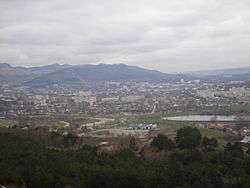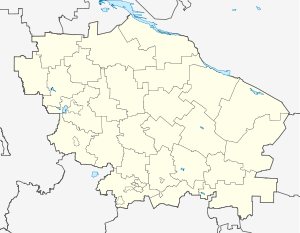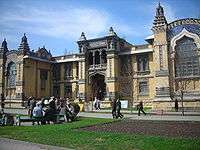Kislovodsk
| Kislovodsk Кисловодск (Russian) | |
|---|---|
| - City[1] - | |
 Panoramic view of Kislovodsk from Mount Koltso-gora | |
.svg.png) Location of Stavropol Krai in Russia | |
 Kislovodsk | |
.png) |
.png) |
Coat of arms |
Flag |
| City Day | last Saturday in May |
| Administrative status (as of July 2011) | |
| Country | Russia |
| Federal subject | Stavropol Krai[1] |
| Administratively subordinated to | city of krai significance of Kislovodsk[1] |
| Administrative center of | city of krai significance of Kislovodsk[1] |
| Municipal status (as of July 2010) | |
| Urban okrug | Kislovodsk Urban Okrug[2] |
| Administrative center of | Kislovodsk Urban Okrug[2] |
| Head | Aleksandr Kurbatov |
| Representative body | Council of Deputies |
| Statistics | |
| Area (2010) | 72 km2 (28 sq mi)[3] |
| Population (2010 Census) | 128,553 inhabitants[4] |
| - Rank in 2010 | 128th |
| Density | 1,785/km2 (4,620/sq mi)[5] |
| Time zone | MSK (UTC+03:00)[6] |
| Founded | 1803[7] |
| City status since | 1903 |
| Postal code(s)[8] | 357700 |
| Dialing code(s) | +7 87937 |
| Website |
kislovodsk-kurort |
| Kislovodsk on Wikimedia Commons | |
Kislovodsk (Russian: Кислово́дск, lit. sour waters) is a spa city in Stavropol Krai, Russia, in the North Caucasus region of Russia which is located between the Black and Caspian Seas. Population: 128,553 (2010 Census);[4] 129,788 (2002 Census);[9] 114,414 (1989 Census).[10]
History
In 1803 Tsar Alexander I of Russia ordered the construction of the military station which became Kislovodsk. The site took its name from the many mineral springs around the city. The settlement gained town status in 1903.
In the late 19th and early 20th centuries, Kislovodsk as a fashionable spa attracted many musicians, artists, and members of the Russian aristocracy. Several of the events in Mikhail Lermontov's 1840 novel A Hero of Our Time take place in Kislovodsk.
 The 19th-century building of narzan baths
The 19th-century building of narzan baths- View of the city from the Little Saddle in the upper park at sunset
 St. Nicholas' Orthodox Cathedral
St. Nicholas' Orthodox Cathedral
Archaeology
Numerous ancient settlements of the Koban culture (ca. 1100 to 400 BC) are found in the Kislovodsk city and its surroundings.[11] They include the sites of Industria I, Sultan-gora I, Berezovka I, Berezovka II, Berezovka III, Berezovka IV, etc.
Administrative and municipal status
Within the framework of administrative divisions, it is, together with seven rural localities, incorporated as the city of krai significance of Kislovodsk—an administrative unit with the status equal to that of the districts.[1] As a municipal division, the city of krai significance of Kislovodsk is incorporated as Kislovodsk Urban Okrug.[2]
Notable people
The most famous native of Kislovodsk was Nobel Prize winner Aleksandr Solzhenitsyn (1918-2008). A museum is planned in the house he was born in. It is set to undergo renovations in 2011 in preparation. Nikolai Yaroshenko's (1846-1898) memorial house is open to the public.
Mother Thekla (Marina Sharfe) was born in Kislovodsk in 1918. She was abbess of the Monastery of the Assumption at Normanby near Whitby in North Yorkshire, England.
The notable Ukrainian historian Mykhailo Hrushevskyi (1866-1934) died when on exile to Kislovodsk in 1934, under circumstances which remain mysterious and controversial.
In literature
Kislovodsk is prominently depicted in the Prix Goncourt–winning 2006 novel The Kindly Ones, as the setting of October 1942 celebration of Uraza Bairam, the breaking of the fast that ends the month of Ramadan. The ceremony, attended by most of the SS and Wehrmacht officers in the area, was described in great detail. The highlight of the feast was the local tribe's presentation of a gift horse intended for Adolf Hitler to the Germans.[12]
Twin towns and sister cities
Kislovodsk is twinned with:
References
Notes
- 1 2 3 4 5 Resolution #63-p
- 1 2 3 Law #88-kz
- ↑ Управление Росреестра по Ставропольскому краю. "Доклад о состоянии и использовании земель Ставропольского края в 2010 году" (PDF). , p. 53 (1.2 MB) (in Russian)
- 1 2 Russian Federal State Statistics Service (2011). "Всероссийская перепись населения 2010 года. Том 1" [2010 All-Russian Population Census, vol. 1]. Всероссийская перепись населения 2010 года (2010 All-Russia Population Census) (in Russian). Federal State Statistics Service. Retrieved June 29, 2012.
- ↑ The value of density was calculated automatically by dividing the 2010 Census population by the area specified in the infobox. Please note that this value may not be accurate as the area specified in the infobox does not necessarily correspond to the area of the entity proper or is reported for the same year as the population.
- ↑ Правительство Российской Федерации. Федеральный закон №107-ФЗ от 3 июня 2011 г. «Об исчислении времени», в ред. Федерального закона №271-ФЗ от 03 июля 2016 г. «О внесении изменений в Федеральный закон "Об исчислении времени"». Вступил в силу по истечении шестидесяти дней после дня официального опубликования (6 августа 2011 г.). Опубликован: "Российская газета", №120, 6 июня 2011 г. (Government of the Russian Federation. Federal Law #107-FZ of June 31, 2011 On Calculating Time, as amended by the Federal Law #271-FZ of July 03, 2016 On Amending Federal Law "On Calculating Time". Effective as of after sixty days following the day of the official publication.).
- ↑ 210 добрых дел Archived July 1, 2013, at Archive.is
- ↑ Почта России. Информационно-вычислительный центр ОАСУ РПО. (Russian Post). Поиск объектов почтовой связи (Postal Objects Search) (in Russian)
- ↑ Russian Federal State Statistics Service (May 21, 2004). "Численность населения России, субъектов Российской Федерации в составе федеральных округов, районов, городских поселений, сельских населённых пунктов – районных центров и сельских населённых пунктов с населением 3 тысячи и более человек" [Population of Russia, Its Federal Districts, Federal Subjects, Districts, Urban Localities, Rural Localities—Administrative Centers, and Rural Localities with Population of Over 3,000] (XLS). Всероссийская перепись населения 2002 года [All-Russia Population Census of 2002] (in Russian). Retrieved August 9, 2014.
- ↑ Demoscope Weekly (1989). "Всесоюзная перепись населения 1989 г. Численность наличного населения союзных и автономных республик, автономных областей и округов, краёв, областей, районов, городских поселений и сёл-райцентров" [All Union Population Census of 1989: Present Population of Union and Autonomous Republics, Autonomous Oblasts and Okrugs, Krais, Oblasts, Districts, Urban Settlements, and Villages Serving as District Administrative Centers]. Всесоюзная перепись населения 1989 года [All-Union Population Census of 1989] (in Russian). Институт демографии Национального исследовательского университета: Высшая школа экономики [Institute of Demography at the National Research University: Higher School of Economics]. Retrieved August 9, 2014.
- ↑ Sabine REINHOLD, Dmitri S. KOROBOV, The Kislovodsk basin in the North Caucasian piedmonts – archaeology and GIS studies in a mountain cultural landscape. 2007
- ↑ Johnathan Littell (2006). Les Bienveillantes. pp. 267–270.
- ↑ "Batumi - Twin Towns & Sister Cities". Batumi City Hall. Archived from the original on 2012-05-04. Retrieved 2013-08-10.
Sources
- Правительство Ставропольского края. Постановление №63-п от 4 мая 2006 г. «Об утверждении реестра административно-территориальных единиц Ставропольского края», в ред. Постановления №75-п от 5 марта 2015 г. «О внесении изменения в пункт 47 Раздела II Реестра административно-территориальных единиц Ставропольского края, утверждённый Постановлением Правительства Ставропольского края от 04 мая 2006 г. №63-п». Вступил в силу с 4 мая 2006 г.. Опубликован: "Сборник законов и других правовых актов Ставропольского края", №17, ст. 5609, 10 июля 2006 г. (Government of Stavropol Krai. Resolution #63-p of May 4, 2006 On the Adoption of the Registry of the Administrative-Territorial Units of Stavropol Krai, as amended by the Resolution #75-p of March 5, 2015 On Amending Item 47 of Section II of the Registry of the Administrative-Territorial Units of Stavropol Krai Adopted by Resolution #63-p of the Government of Stavropol Krai of May 4, 2006. Effective as of May 4, 2006.).
- Государственная Дума Ставропольского края. Закон №88-кз от 4 октября 2004 г. «О наделении муниципальных образований Ставропольского края статусом городского, сельского поселения, городского округа, муниципального района», в ред. Закона №51-кз от 28 мая 2015 г. «О преобразовании муниципальных образований, входящих в состав Минераловодского муниципального района Ставропольского края (Минераловодского территориального муниципального образования Ставропольского края), и об организации местного самоуправления на территории Минераловодского района Ставропольского края». Вступил в силу со дня официального опубликования. Опубликован: "Ставропольская правда", №216, 6 октября 2004 г. (State Duma of Stavropol Krai. Law #88-kz of October 4, 2004 On Granting the Status of Urban, Rural Settlement, Urban Okrug, Municipal District to the Municipal Formations of Stavropol Krai, as amended by the Law #51-kz of May 28, 2015 On the Transformation of the Municipal Formations Within Mineralovodsky Municipal District of Stavropol Krai (Mineralovodskoye Territorial Municipal Formation of Stavropol Krai), and on the Organization of the Local Self-Government on the Territory of Mineralovodsky District of Stavropol Krai. Effective as of the day of the official publication.).
External links
- Official website of Kislovodsk (in Russian)
